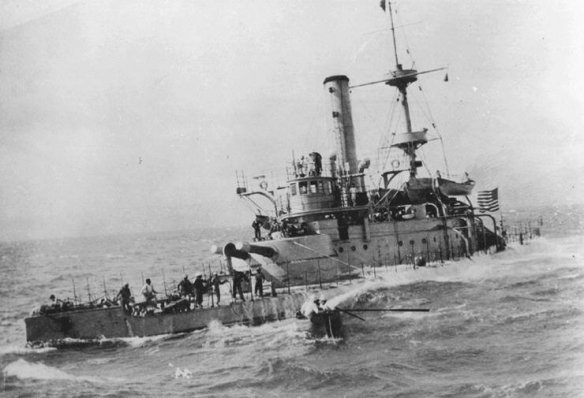Monadnock crossing the Pacific Ocean during the Spanish-American War. This must have been an ‘exciting’ crossing…
A monadnock of more than 3,100 feet in southern New Hampshire close to the border of Massachusetts; often called Grand Monadnock to distinguish it from Little Monadnock which lies nearby to the east.
The second Monadnock, an iron‑hulled, twin‑screw, double‑turreted monitor, was laid down by Phineas Burgess at the Continental Iron Works, Vallejo, Calif., in 1874; launched 19 September 1883; completed at Mare Island Navy Yard; and commissioned there 20 February 1896, Capt. George W. Sumner in command.
After fitting out Monadnock served as a unit of the Pacific Squadron along the west coast. During the next 2 years exercises and training cruises sent her along the Pacific coast from Puget Sound to Baja California. After the outbreak of war with Spain, she was ordered to join Dewey’s fleet in the Philippines. She departed San Francisco 23 June 1898, touched at Hawaii early in July, and reached Manila Bay 16 August. She operated on blockade duty in the Manila‑Marviles‑Cavite area, with brief voyages to Hong Kong, until December 1899. On 26 December, she sailed for Hong Kong and for the next 5 years, cruised the rivers of China, particularly the Yangtze, and along her coast to protect American interests. Between 27 January and 7 October 1901, she stood almost continuous duty at the mouth of the Yangtze protecting the foreign settlement at Shanghai, operating similarly on four other occasions: 6 December 1902 to 8 April 1903; 18 September 1903 to 10 March 1904; and 8 April 1904 to 28 November 1904.
On 3 February 1905 she returned to Cavite. Operating out of Olongapo, she remained in the Philippines, with two interruptions for brief visits to Hong Kong, until decommissioned at Cavite 10 March 1909. Recommissioned in reserve 20 April 1911, she resumed operations out of Olangapo, until placed in full commission 31 January 1912 at Cavite. For the next 7 years she cruised with submarines, and towed targets. Decommissioning for the last time 24 March 1919, her name was struck from the Navy list 2 February 1923, and her hull was sold, on the Asiatic Station, 24 August 1923.
#
In the Philippines, the U.S. government simply substituted its rule for that of Spain. Whereas the Cubans reacted more or less docilely, Philippine insurrectionists under Emilio Aguinaldo waged a bitter struggle against what came to be an American garrison of more than sixty thousand men. Forty-two hundred Americans and about five times that many Filipinos died during a four-year guerilla war. Ambush was countered by burning villages and crops; torture became routine on both sides; atrocity was met with counter-atrocity. The conflict generated sensation, courtsmartial, prisoner-of-war issues, and growing anguish in both the islands and the United States that eerily prefigured the Vietnam years. For the first but not last time in the twentieth century the United States found itself caught up in a dehumanizing Asian campaign. Commenting on the infamous “Samar Expedition” by soldiers seeking bloody and somewhat indiscriminate revenge against insurrectionists who had massacred an army patrol, a young marine—conveniently ignoring two hundred years of mutually vicious frontier warfare with Native Americans—wrote that “subduing savages is a new thing to the American people and they will howl at the necessary adjuncts.” But the commander of the punitive Samar raid had done only “what others have done—except that he failed to kill them all—if he had done the latter, who would have told the tale? Whatever you do; do thoroughly.”
The navy and its marine corps performed a wide variety of blue- and brownwater tasks all over the archipelago. Amphibious assaults were launched at Lingayen Gulf and elsewhere as the army sought to flush out the guerrilla enemy. Monitors and destroyers bombarded rebel strongholds, while shallow-draft gunboats and other craft were employed in search-and-destroy operations “upriver.” When Aguinaldo was at last captured by ruse in his mountain stronghold, he was hustled to the closest beach and taken away in the cruiser Vicksburg.
As Kenneth Hagan has observed, the Philippine campaign, like Vietnam later, was no battleship war. Unlike Vietnam, however, the island insurgents enjoyed no adjacent sanctuary, no “impregnable base” next to the battlefields, as the Viet Cong and later North Vietnamese Army did after 1965. Aguinaldo and his people were sealed off and isolated by the United States Navy, allowing the army to encircle and gradually destroy them.
